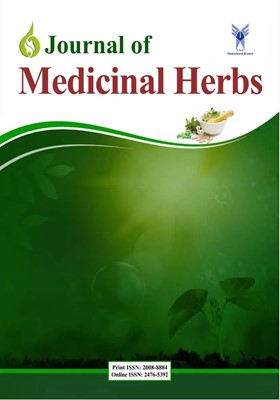تأثیر روش های آون و سایه خشک بر درصد و اجزای اسانس کلوس (Kelussia odoratissima Mozaff)
Subject Areas : Journal of Medicinal Herbs, "J. Med Herb" (Formerly known as Journal of Herbal Drugs or J. Herb Drug)
فرنام میرحسینی
1
,
مهدی رحیم ملک
2
,
عبدالله قاسمی پیربلوطی
3
![]()
1 - گروه گیاهان دارویی، دانشگاه آزاد اسلامی واحد شهرکرد
2 - گروه زراعت و اصلاح نباتات، دانشکده کشاورزی، دانشگاه صنعتی اصفهان
3 - 1- مرکز تحقیقات گیاهان دارویی و دام پزشکی سنتی، دانشگاه آزاد اسلامی واحد شهرکرد
2- بخش گیاهان دارویی، کالج علوم طبیعی، دانشگاه ماساچوست، آمهرست، آمریکا
Keywords: اسانس, کلوس, روش های خشک کردن, ترانس لیگوستیلید,
Abstract :
مقدمه و هدف: کلوس ((Kelussia odoratissima Mozaff یکی از گیاهان ارزشمند خانواده چتریان Apiaceae)) است که به عنوان گیاه دارویی و ادویهای مورد استفاده قرار میگیرد. با توجه به اهمیت خشک کردن بر کمیت و کیفیت اسانس، در این تحقیق اثر دو روش خشک کردن بر درصد و اجزای اسانس مورد بررسی قرار گرفت. روش تحقیق: آزمایش به صورت طرح کاملاً تصادفی در سه تکرار در مرکز تحقیقات گیاهان دارویی شهرکرد انجام شد. تیمارها شامل خشک کردن در دمای محیط (سایه) و آون (45 درجه سانتی گراد) و نمونه تر (گیاه تازه) بود. اجزای اسانس ها به روش تقطیر با آب به وسیله دستگاه GC و GC/MSتجزیه و شناسایی شدند. نتایج و بحث: نتایج به دست آمده نشان داد که تفاوت معنی داری بین دو روش مورد استفاده در میزان و درصد ترکیبات اسانس وجود داشته است. بازده اسانس در روش های خشک کردن در سایه و آون به ترتیب 50/1 و 26/1 درصد بود. بیشترین درصد ترکیب اسانس در کلیه روش ها سیس لیگوستیلید بود که بیشترین میزان آن (3/68 درصد) در آون 45 درجه سانتی گراد و کمترین میزان این ترکیب در اسانس نمونه تر (6/16) درصد بود. بالاترین میزان تیمول در اسانس حاصل از نمونه تر 33/12 درصد بود که تفاوت معنی داری با سایر روش ها داشت. توصیه کاربردی صنعتی: نتایج این تحقیق تأثیر مثبت خشک کردن در دمای محیط (سایه) در افزایش بازده و ترکیبات اسانس را نشان داد.
dams, R., 2001. Identification of essential oil components by gas chromatography/ quadrupole mass spectrometry. Carol Stream, Illinois, USA: Allured Publishing Corporation. pp. 456.
Ahmadi, F., Kadivar, M. and Shahedi, M., 2007. Antioxidant activity of Kelussia odoratissima Mozaff. in model and food systems. Food Chemistry., 105: 57–64.
Dadkhah Tehrani, Z., 1999. Study of phytochemical of Kelussia odoratissima. Thesis on Doctra of Pharmacy. School of Pharmacy, Isfahan of Medicial University, Isfahan, Iran.
Ghasemi Pirbalouti, A. G., Setayesh, M., Siahpoosh, A. and Mashayekhi, H., 2013a. Antioxidant activity, total phenolic and flavonoids contents of three herbs used as condiments and additives in pickles products. Herba Polonica, 59(3): 51-62.
Ghasemi Pirbalouti, A., 2009. Medicinal plants used in Chaharmahal and Bakhtyari districts, Iran. Herba Polonica., 55: 69-75.
Ghasemi Pirbalouti, A., Mahdad, E. and Craker, L., 2013b. Effects of drying methods on qualitative and quantitative properties of essential oil of two basil landraces. Food Chemistry., 141(3): 2440-2449.
Ghasemi Pirbalouti, A., Oraie, M., Pouriamehr, M., & Babadi, E. S. (2013c). Effects of drying methods on qualitative and quantitative of the essential oil of Bakhtiari savory (Satureja bachtiarica Bunge.). Industrial Crops and Products., 46, 324-327.
Pirbalouti, A. G., Sedaghat, L., Hamedi, B. and Tirgir, F., 2014. Chemical composition and antioxidant activity of essential oils of three endemic medicinal plants of Iran. Bangladesh Journal of Botany., 42(2): 327-332.
Jalil, A. and Jamzad, Z., 1999. Red data book of Iran: A preliminary survey of endemic, rare and endangered plant species in Iran. Research Institute of Forests and Rangelands, Tehran, Iran, pp. 748.
Moyler, D. A., 1994. Spices-Recent Advances. In: Spices, Herb and Edible Fungi, Ch Aralambous, G. Elsevier Science London, UK., pp. 1-7.
Mozaffarian, V., 1998. A dictionary of Iranhan plants names. Tehran: Farhang Moaser Publishers. pp. 547-548.
Omidbaigi, R., 2005. Production and processing of medicinal plants. Beh-Nashr Publications Mashhad. Vol. 2, pp. 438 (in Farsi(.
Omidbaigi, R., Sefidkon, F. and Kazemi, F., 2003. Influence of drying methods on the essential oil composition of Roman Chamomile. Flavour and Fragrance Journal., 19: 196-198.
Ozcan, M. Arslan, D. and Unver, A., 2005. Effect of drying methods on the mineral content of basil (Ocimum basilicum L.). Journal of Food Engineering., 69: 375–379.
Rabbani, M., Sajjadi, S.E. and Sadeghi, M., 2011. Chemical composition of the essential oil from Kelussia odoratissima Mozaff and the evaluation of its sedative and anxiolytic effects in mice. Clinics., 66: 843–848.
Rahimmalek, M., Sayed Tabatabaei, B.E., Etemadi, N., Goli, S.A.H., Arzani, A. and Zeinali H., 2009. Essential oil var iation among and within six Achillea species transferred from different ecological regions in Iran to the field conditions. Industrial Crops and Products., 29: 348-355.
Sajjadi, S. E., Shokoohinia, Y. and Mehramiri, P., 2013. Isolation and characterization of steroids, phthalide and essential oil of the fruits of Kelussia odoratissima Mozaff., an endemic mountain celery. Research in Pharmaceutical Sciences, 8(1): 35.
Sefidkon, F. Abbasi, K. and Bakhshi, K.G (2006). Influence of drying and extraction methods on yield and chemical composition of the essential oil of Satureja hortensis. Food Chemistry., 99: 19–23.
Sellami, M.I., Wannes, W.A., Berrima, S., Chahed, T. and Limam, F., 2011. Qualitative and quantitative changes in the essential oil of Laurus nobilis L. leaves as affected by different drying methods. Food Chemistry., 126: 691–697.
Soltani, L., 2008. Study of anti-iflamatory and sedative of Amirkabiria odoretascima. Thesis on Doctra of Pharmacy. School of Pharmacy, Isfahan of Medicial University, Isfahan, Iran.


